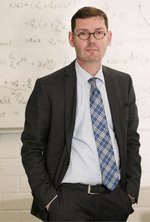
Physics
Most physicists appreciate the freedom that typical basic physics research gives them to also follow up chance discoveries. Often, technical application of their work may not be directly apparent, only to emerge decades later. Nevertheless, as this research report shows, the members of the research groups within our faculty are indeed interested in whether their results can be used in interesting applications. An increase in research funding, which specifically encourages early collaboration with industry, is supporting our researchers in their efforts.
It is on this basis that the research group of Prof. Heiko Wende is working in an EU project with Seagate and Uppsala University in Sweden. Hard disk drives are by no means a thing of the past when it comes to cloud storage systems, an area in which the use of rare earth elements in metallic layer structures promises a significant expansion in capacity. But maybe the answer to the storage issue lies in another of the Wende group’s research areas, multiferroic systems, which can be extremely small because the virtual absence of a current during storage means that little to no heat is generated.
The work in the research group of Prof. Marika Schleberger considers ions in an entirely different capacity. Here, the ions create nanometre-sized pores in materials and have potential as filter membranes for e. g. viruses, so it comes as little surprise that industry is keen to be involved in their development.
Prof. Axel Lorke lost no time in applying for a patent when it became clear that the silicon-iron compound nanoparticles fabricated in his research group can be used as a type of battery as soon as they are introduced between electrodes to which a voltage is applied.
In its specialist area of chaotic systems, the research group of Prof. Thomas Guhr has been able to show the dramatic extent to which the mutual dependencies of borrowers increases credit risk.
These and other examples of the work in the faculty are described in greater detail in the following report.

